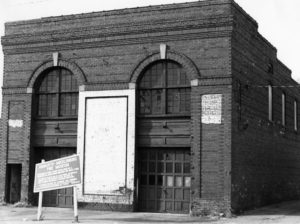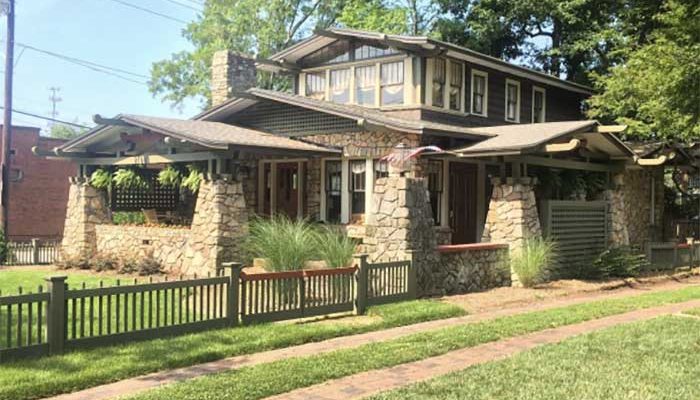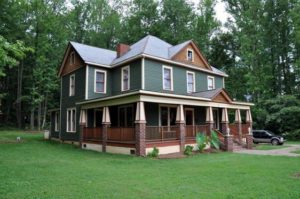
1. Name and location of the property: The property known as the William Sidney and Margaret Davis Abernethy House is located at 215 W. Eastway Drive, Charlotte, NC 28213
2. Name, address, and telephone number of the present owners of the property:
Angelene Melton Dunlap, Scotty E. Dunlap, and Jerry Colson, Jr.
13217 Pinion Road
Norwood, NC 28128
3. Representative photographs of the property: This report contains representative photographs of the William Sidney and Margaret Davis Abernethy House
4. A map depicting the location of the property:
5. Current tax parcel reference and deed to the property: The tax parcel number of the property is 08911116. The most recent deed to this property is recorded in Mecklenburg County Deed Book 27234 pages 713-716. UTM coordinates are 539771.8 E, 8933665.5 N.
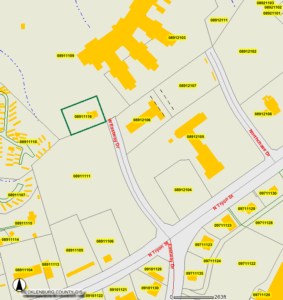

6. A brief historical sketch of the property: This report contains a brief historical sketch of the William Sidney and Margaret Davis Abernethy House.
7. A brief architectural description of the property: This report contains a brief architectural description of the William Sidney and Margaret Davis Abernethy House.
8. Documentation of why and in what ways the property meets the criteria for designation set forth in N.C.G.S. 160A-400.5:
a. Special significance in terms of its history, architecture, and/or cultural importance:
The William Sidney and Margaret Davis Abernethy House is one of the few remnants of the agricultural economy that once thrived near the city of Charlotte before World War II. The house is also an important artifact of dairy farming in Mecklenburg County early in the twentieth century.
b. Integrity of design, setting, workmanship, materials, feeling, and/or association: The Commission contends that the physical and architectural description which is included in this report demonstrates that the William Sidney and Margaret Davis Abernethy House meets this criterion.
9. Ad Valorem Tax Appraisal: The Commission is aware that designation would allow the owner to apply for an automatic deferral of 50% of the Ad Valorem taxes on all or any portion of the property which becomes a designated “historic landmark.” The current appraised value of the property is $346,000.
10. Portion of the property recommended for designation: The interior and exterior of the house and the property associated with the tax parcel are recommended for historic designation.
Date of preparation of this report: September 2012
Prepared by: Susan Mayer
William Sidney and Margaret Davis Abernethy House
The William Sidney and Margaret Davis Abernethy House was built circa 1914. William Sidney “W.S.” Abernethy was born on November 28, 1863, in the Hopewell community of western Mecklenburg County, and died on October 14, 1942, at the age of 78. He was the son of John Connelly Abernethy and Nancy Jane Blythe Abernethy.[1] W.S. married Margaret “Maggie” Davis on March 25, 1902.[2] Born on September 20, 1862, in Mecklenburg County, Maggie was the daughter of John Sample Davis and Catherine Alexander Davis, a distant cousin of Hezekiah Alexander. She was reared on the Sugar Creek farm her Alexander ancestors received as a land grant from the king of England. Maggie, who died on May 28, 1971, notably lived to the age of 108.[3] She resided her entire life in Mecklenburg County, most of it on family land. Even the Shamrock Drive nursing home in which she spent the last six years of her life was on land originally owned by the Alexander family.[4]
This 1911 map of Mecklenburg County includes the farm of W.S. Abernethy in the Paw Creek township.
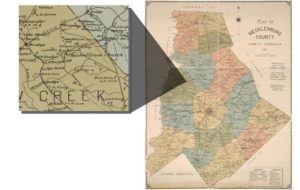
W.S. was a prominent farmer in the Hopewell community. His farm, located along Rozzelles Ferry Road, was large enough for W.S. to employ two hired men.[5] At the Charlotte Fair in 1912, he was noted for his extensive exhibition of agricultural products, including “meadow hay, wheat straw barley, two-eared corn, rye, hay apples, oats, strawberry corn, buckwheat, orchard grass pumpkins, beets, turnips, oranges, sunflower, tobacco, sides of meats, artichokes, and two bales of King cotton.”[6] He was one of three farmers selected in Paw Creek township to solicit the County Commission for aid in combating corn crop pests.[7] W.S.’s high standing within the community is also demonstrated by his inclusion on a 1911 map of Mecklenburg County. Despite his success, the location of the farm was too far from Charlotte–nine miles from the Square at Trade and Tryon streets–which made the sale of his crops difficult. Automotive travel in Mecklenburg County was in its infancy, and few roads were paved. Additionally, areas far removed from Charlotte would be slow to receive new amenities such as electricity. An opportunity soon arose to meet better the Abernethy family farm’s needs.
In 1913, after the death of Maggie’s mother, W.S. and Maggie inherited a portion of the Alexander land in the Sugar Creek community. Located along the Salisbury road near the Southern Railway tracks, the 450 acres of land was ideal for the cultivation and sale of cash crops. Members of the Alexander family had lived on the land for generations. A small community had sprung up to support the nearby farms, including a general store at the intersection of the Salisbury road and Old Potters road. Also, the inherited property was half the distance to Charlotte—less than five miles from Sugar Creek to the Square—than their current location in Hopewell. The Newell community was nearby, making the railroad easily accessible. The Abernethys, along with their three children, William Sidney Jr. (1904-2000), Nancy Katherine (1907-1997), and Emelyn (1909-1986), moved to a new farmhouse they constructed on the property along the Salisbury road. W.S. and his sons drove their cattle from Hopewell to the new farm. With the move, W.S. was poised to make a transition to a new agricultural industry that was sweeping the county and state: dairying.[8]
Farming in Mecklenburg County
Following the Civil War, Mecklenburg County fared better than many areas of the former Confederacy. The large plantations stereotypically associated with the South were few, with small farms comprising most of the county’s agricultural economy—the average farm size was 100 acres.[9] Crop cultivation was varied, including corn, wheat, cotton, peanuts, potatoes, and other products. But money was scarce, and the ease of transforming cotton into cash made it an alluring crop. Agriculture in Mecklenburg County, like much of the South, came to be dominated by cotton. Cotton was not easy to grow in the area, mostly due to farmers’ inability to cultivate the crop properly, and only 6,112 bales were ginned in the county in 1860. However, the discovery of Peruvian guano fertilizer in 1865 led to a rapid increase in cotton production. By 1880, nearly 20,000 bales of cotton were produced in Mecklenburg County. This economic growth resulted in a dramatic change in the image and lifestyle of local farmers. Many farmers built larger and more ornate homes than had previously characterized rural domestic architecture. Examples of this prosperity may be found in such Mecklenburg County farmhouses as the Thomas Alexander house (1903), the N.S. Alexander house (1903), and the James A. Blakeney house (1905). But not all of Mecklenburg County’s small farmers enjoyed this prosperity. The tenant system represented an unending cycle of debt. Farmers purchased seed, fertilizer, and other goods on credit and then toiled in the fields hoping their crop would produce enough to pay off their debts to both stores and landowners. Drought, boll weevils, or other threats to cotton could wipe out an entire crop, leaving the farmer with little or no income.[10]
Another issue facing Mecklenburg County was its food supply. Although over 90 percent of the county was rural farmland in 1910, the area imported much of its food.[11] In 1920 the county produced $3,940,837 of food, but consumed an amount worth $13,920,589. This was common throughout the state as well, since only three counties–Currituck, Alleghany, and Camden–produced surplus food. In his study of Mecklenburg County’s agricultural and economic structure, Edgar T. Thompson, a professor in the Department of Rural Social-Economics at the University of North Carolina at Chapel Hill, identified three reasons for the shortage: the monopoly of cotton, tenant farming, and local market issues. The continued growth of cotton constituted a paradox for Mecklenburg County farmers, for credit was based upon cotton acreage. As Thompson notes, local farmers would “rather gamble with the hazards of the cotton market than to fool away time with food and feed crops that they have trouble turning into cash at a fair price and profit.”[12] Likewise, the tenant farm system emphasized a reliance upon cash crops. But even if Mecklenburg County farmers did produce more food products, a well-developed cash market for these products was lacking in Charlotte. This circumstance made the transition to a new cash crop difficult, and many farmers preferred to stay with the current system of cotton farming. However, an alternative cash crop for Mecklenburg County farmers would develop in the late nineteenth century.[13]
Dairy Farming in Mecklenburg County
Dairying, or the keeping of cows for milk, had existed in North Carolina since the arrival of settlers, but its scale was predominately limited to a cow or two for home usage. In fact, dairy farming as an industry was a later addition to American agriculture. The growth of the dairy industry historically has been tied to the growth of cities and metropolitan areas. The primary dairy-producing states for much of the nineteenth century were New York and Pennsylvania, which supplied New York City, and Wisconsin, which exported milk, cheese, and butter to Chicago. The manufacturing of dairy products started in New York, with the first American cheese factory opening in Oneida County in 1851 and the first creamery in Orange County in 1861.[14] Dairying in North Carolina and much of the southern states would not develop until the turn of the twentieth century. Even up until 1910, North Carolina did not have a cheese or butter manufacturing plant, for these products were made solely on farms, then traded or sold to general stores for family necessities.[15]
Scrub cattle, or “native” locally-evolved breeds, were present in Mecklenburg County until the introduction of shorthorn cattle by Adam Brevard Davidson (1808-1896), owner of Rural Hill Plantation, in the nineteenth century. Later, a breed local to Georgia was also brought into the county. These three strains of cattle were bred to create a hardy animal that produced much milk. In the 1880s, Sydenham Benoni Alexander (1840-1921) brought in Jersey cows from New York and Pennsylvania. Jersey cows were a preferred breed of dairy cow because of the higher volume of cream in their milk. Although many of the cows died of tick fever, enough survived to serve as breeding stock. Alexander bred the cattle to improve the stock in Mecklenburg County rather than to profit. Local farmers, preferring the cultivation of cotton, mockingly referred to his livestock as “Cap’n Sid’s little fawn cows.”[16] Other farmers in the county also brought in Jerseys for breeding, including Rufus Barringer, a well-known general of the Confederate army and former Charlotte lawyer, and John Springs Davidson, son of Adam Brevard Davidson. Dairy farming was slow to catch on with small farmers, though. By the turn of the century, only 917 of 224,637 North Carolina farms derived their principal income from dairying.[17]
By 1907, the popularity of the Jersey cow was spreading to larger-scale operations. Edgar Blackburn Moore (1871-1916), proprietor of the Selwyn Hotel in Charlotte, purchased Jerseys from farmers in Thomasboro and Durham, North Carolina, and Tennessee to create a herd for both breeding and the promotion of the area dairy industry. Moore named his establishment, located along what is now known as Marsh Road in south Charlotte, Selwyn Farms.[18] The farm was established to provide for his hotel fresh vegetables, fruits, and other foods, which he complained that Charlotte did not have the infrastructure to provide. This practice was common among hotel owners–Moore had previously been the proprietor of the Kenilworth Inn in Asheville, and had also established a farm to supply that business with food products.[19] His plans for an up-to-date and modern farm, “which might serve as a pattern for others in this section of the State,” contributed to the advancement of the dairy industry in Mecklenburg County.[20] Technological advances introduced by Selwyn Farms included milking by compressed air and a sterilizing machine, “the only one of its kind in the South except that at Biltmore.”[21] After Moore died in 1916, his herds were sold to farmers in and around Mecklenburg County at auction, thus spreading the breeding stock he had established. Later dairy farmers commented that Moore did more to improve the livestock in the county than anyone else at that time.
Government involvement also played a part in the development of the dairy industry in Mecklenburg County. North Carolina recognized the potential for the state to become a regional leader in the industry, and research and education about dairying was greatly expanded by both the state and federal governments. The agricultural experiment station run by North Carolina Agricultural and Mechanical College highlighted dairy farming in its May 1905 farm bulletin. In the interests of expanding the industry throughout the state, the bulletin sought to “bring about a better understanding of the most approved methods of handling dairy products, as well as a much needed improvement in the products of our dairies.”[22] The publication provided an overview of the various equipment and supplies needed to operate a dairy of twenty cows, with an estimated total cost of $200. North Carolina farmers averaged $398 in products produced on farms in 1900, with $45 of that amount being products fed to farm livestock.[23] While the cost of equipment was not cheap, it certainly could have been an affordable option for a farmer who may have wanted to switch from cotton farming to dairying. In 1906, the U.S. Department of Agriculture began placing agents in each county to educate local farmers about technology and methodologies to increase crop yields. Additionally, in 1916 the state agricultural college split dairy farming, which had previously been incorporated into animal husbandry, into a new department in its school of agriculture. However, these efforts benefited the large-scale commercial farmer more than family farms. The federal Extension Service had linked college programs such as this with large commercial farmers, who already controlled the county agents, to promote the agricultural industries. This situation made it difficult for small farmers, and even more so for their tenants, to get the help they truly needed.
In the 1910s, dairy farming found its niche as a emerging cash crop in Mecklenburg County. A 1913 editorial in the Charlotte Observer extolled the promises of this industry, noting
The incorporated dairy farm which will operate 400 acres in this county, producing meat, milk and butter, is just the sort of enterprise which this section most needs. It and all other intelligent producers of such articles have a rich field. Down with cotton as the only important crop on any farm![24]
Judging by his embracing of dairying, this sentiment was certainly shared by W.S. Abernethy. Publications for dairy farmers were widely available. A probable guide would have been Dairy Farming, a complete primer on the needed equipment and knowledge to start a dairy farm, first published in 1907 by John Michels, a former professor of dairying and animal husbandry at the state agricultural college. Michels’s work covered the broad range of dairy farming, from the small family farm to the larger commercial operation. He was a major proponent of the dairy industry and taught a dairying course for one-year agriculture students to “meet the requirements of the farmer and dairyman who handle dairy products, whether for home use or for commercial purposes.”[25]
Due to both the explosive growth of Charlotte and the subsequent rise in dairies surrounding the city, the Charlotte city council passed an ordinance regulating the production and sale of milk on February 6, 1914. Scheduled to go into effect on the first of March, the ordinance required farmers selling milk within the city to purchase a $1 permit. Also, the grading of raw milk sold to the public was heavily emphasized. As established by the ordinance, Grade A milk would contain less than 100,000 bacteria per cubic centimeter (and a maximum of 25,000 when pasteurized and delivered to the consumer). While Grade B milk had requirements of less than 500,000 bacteria per cubic centimeter (50,000 when pasteurized and delivered to the public), graduated decreases in the amount of bacteria allowed in the milk would bring these dairies to the Grade A level within 18 months. The dairy’s facilities were also regulated. Farmers were required to have a milk room and bottling stations that were “clean, light, and well-screened.”[26] Workers must adhere to safety and cleanliness guidelines as well as frequently sterilize equipment. Cows were to be examined by a veterinarian every six months, and any new cows must be inspected by a city official. Six months after the ordinance was passed, 105 dairy permits had been issued, and 119 dairies had been inspected.[27]
After World War I, dairy farming in the South began to expand rapidly, and Mecklenburg County was no exception. Locally, farmers were banding together to improve jointly the dairy industry in Mecklenburg County. The establishment of associations in the late 1910s demonstrated that dairy farmers were working together to breed the best cows to produce more of the highest quality milk. Inter-cooperation ranged from shared pure bred bulls for breeding to the purchase of a cooperative milk plant. The Mecklenburg Cooperative Jersey Breeders Association (MCJBA) was established in 1917 to help dairying gain traction as a viable industry in Mecklenburg County. The organization had 175 members within two years. MCJBA held its first sale of cattle on March 19, 1919, with part of the cattle sold being the remaining stock of the Selwyn Farms herd. Thirty head of registered Jerseys sold for an average of $161.50 each, with the top price being $405. A few years later, the Mecklenburg County Cooperative Cow Testing Association was established to regulate and promote the breeding of dairy cows in Mecklenburg County with the hopes that the local herds would become sought-after breeding stock. Dairy farmers also worked with other farm interests to expand the overall agricultural economy in the county through organizations such as the Mecklenburg County Farm Bureau. A meeting held January 6, 1921, included representatives of the local branches of the American Cotton Association, the Jersey Breeders Association, the Milk Producers Association, the community fair association, the Cow Testing Association, and the county credit union.[28]
By 1920, Mecklenburg County led the state in total number of dairy cattle with 12,963 head distributed across 4,344 farms, an increase of 65 percent in the past decade.[29] The size of dairy farms in the county had also changed. The local dairy industry previously had consisted of families with one cow who sold their surplus milk and butter, and dairy was a secondary product of the farm to cotton and corn. The large commercial dairy farm, such as Moore’s Selwyn Farm, was an uncommon entity, regardless of the amount of press attention they received. The Strout Agency reported in 1922 that the average Mecklenburg County dairy farm had eight to twelve cows and that practically all work on the farm was performed by the farmer and his family. Likewise, all members of the Abernethy family helped out on the family farm, whether it was milking the cows, cleaning the equipment and barns, tending the gardens. Corn and other feed products for livestock were also grown, and the sale of dairy products was supplemented with eggs and poultry. Farmers had begun to diversify their cash crops, for “the man who raised sweet corn is at no time in fear of disaster, because even if his sweet corn crop fails, which it is not likely to do, he will still have his dairy giving him two crops a day with a ready market right at home.”[30]
Initially, the distribution of milk in Mecklenburg County was limited to the immediate community. If residents did not produce their own milk, they would purchase it from either a neighboring farm or the local store. Some farmers ran delivery routes though their communities, and would load up a wagon or truck with jars of milk and other products to sale. W.S. Abernethy, who had branded his operation Sundale Dairies, included eggs as part of his delivery, which was a common practice among small dairy farmers. He also included Mission orange drink, sold in small bottles for a nickel each, as easy add-on sales.[31] Farmers would also sell the butter they made to local stores. One former Mecklenburg County farmer remembered that his mother would ask whose butter the store was selling, since certain farms were reputable for producing good, clean butter.[32] Local community distribution would be the norm until the 1920s, when the state Good Roads campaign created infrastructure to transport goods better.
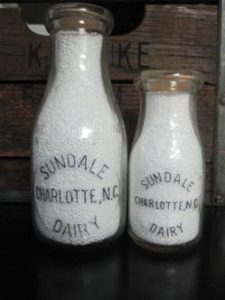

Bottles and cardboard caps used by W.S. Abernethy’s Sundale Dairy. Photos courtesy of Rodney Shore.
Although agriculture would remain a prominent industry in Mecklenburg County, the number of farms would begin to drop by the onset of the Great Depression. The 1920s would represent the peak decade of dairy cattle ownership in the county. As the dairy industry in the county grew, the dairy and farm organizations came to be dominated by the larger-scale farms, and later by dairy plant owners and management. The 1930 census reported 3,773 farms in the county, a drop of nearly 15% from 1920.[33] In 1924, 9,079 dairy cows were milked, and over 1.3 million gallons of whole milk were sold in Mecklenburg County.[34] By 1929, there were only 8,249 dairy cows on 2,712 farms.[35]
One reason for this decline was the growing domination of larger farms. W.S. was classified as a small dairy farmer, usually keeping around 25 cows. Although his total farm was about 450 acres, only a small portion of it was devoted to dairying. In 1930, Mecklenburg County averaged 2.67 acres of farmland per dairy cow. Farms in Mallard Creek township, the census-designated area where the Abernethys lived, devoted about half their land to crops and about one-fifth each to pasture and woodlands.[36] Larger farms, however, could devote more acreage to dairying since sustenance farming was not a part of their operations. The differences facing family dairies versus the commercial farms were evident even a decade earlier. When tentative plans for a new creamery came about in Charlotte, observers noted that
the problems of the smaller producer are not those of the larger producer was demonstrated by statements showing that the large producer requires entirely different equipment and care in handling his milk than the small one, and propositions planned to satisfy one will not prove satisfactory to the other. A solution of the problems of the small producer was said to lie in the conversion of his raw milk into cream, butter, and cheese, using the skim milk derived in the process for the fattening of hogs for it was shown that the small producer is not dependent alone on the dairy industry but relies upon regular agricultural yield.[37]
Additionally, government policy in the fight against the boll weevil tended toward mechanization and investment in technology–something unaffordable to the tenant farmers that made up most of Mecklenburg County’s cotton farmers. New Deal policies would further decimate the numbers of farmers in the county for many of the same reasons. The most notable program was the Agricultural Adjustment Agency, which “set up programs to reduce crop acreage and livestock production and raise prices toward a parity goal…[resulting in] the accelerated driving of small marginal farmers and sharecroppers from the land.”[38]
Despite these changes, the overall health of the dairy farming industry in Mecklenburg County managed to hold steady. However, the ratio of large dairies in comparison to smaller operations increased. In April 1930, 6,880 cows were milked daily on 2,330 farms in the county, producing 10,919 gallons of milk.[39] Sixty-eight dairy farms and plants sold Grade A raw milk in Charlotte, among them W.S. Abernethy, and 173 total sold milk.[40] In 1935, the number of cows milked actually increased to nearly 10,000. Although this turn-around contrasts with the drop in dairy ownership during the previous decade, it may be attributed to the lack of consumer buying power during the Depression, in which many families turned back to sustenance farming to make a living. Also during this period, many farmers ended their cultivation of cotton, and moved into dairying and other agricultural pursuits. The number of farms in Mecklenburg County increased to 4,123, the highest number since 1920.[41]
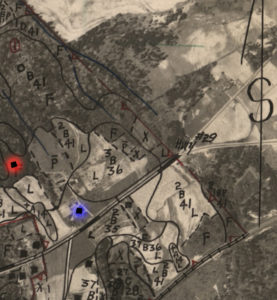
Above: 1938 aerial photos of the Abernethy farm. The blue block was the original location of the house, and the red block is the house’s current location.
W.S. Abernethy died in 1942; but by that time, his son William Sidney Abernethy, Jr., also called W.S., had taken over the operation of the dairy. W.S. Jr. (1904-2000) and his wife Dorothy “Dolly” Bloodworth Abernethy (1907-1988) reared their three children Margaret, William Sidney III, and John, on the family farm. Their farm was the typical small dairy with 25 to 30 cows for milk production. All members of the family took part in running the farm, and W.S. Jr. also had two tenant houses on the land that he rented to hired workers. The family also grew feed products for their cows as well as sustenance crops, and also kept other livestock such as pigs, horses, and chickens. They used mechanical milkers to harvest the milk, although at times they had to milk the cows manually. A piping system ran from the cow barn to the dairy production area into five gallon containers. Workers would then prepare the milk to be poured through the chiller and filter emplacement for bottling. An inspector came regularly to check over the family dairy operations to ensure that the highest standards of cleanliness were being kept. John remembers once instance where a kitten had fallen into a container of milk. The milk had to be poured out, and the container sanitized. It was during this period that Sundale joined the Farmers’ Dairy cooperative, thus ending their direct sale of milk to the public.[42]
Despite a positive outlook for the dairy industry in North Carolina following World War II, many problems still loomed. The state’s agriculture remained heavily devoted to cash row crops, with 71 percent of total farm income in 1946 coming from tobacco, cotton, and peanuts. Dairy cattle and products was ranked fourth. Farmers also imported much of their livestock feed from outside the state, driving up dairy costs. Additionally, there was a skilled labor shortage, for dairy farming required 150 man hours per cow in comparison to less than 100 man hours for other crops.[43] The state turned to education to try to combat this situation. The North Carolina Dairy Foundation partnered with North Carolina State College to provide dairy research and educational programs to expand the prominence of dairying in the state. The college began offering short courses to dairy farmers and other interested parties in 1945, which covered topics ranging from artificial breeding to dairy production and manufacturing.[44] In light of these efforts, dairy foundation president George Coble of Lexington, owner of the one of the largest dairies in the state, remarked that “the land of cotton and tobacco may be become another Dairyland within the next decade.”[45]
The shift to large-scale dairy farming was more and more evident in Mecklenburg County leading into the 1950s. Although over 200 dairy farms reported $1.14 million in dairy products produced in 1945, 36 of those accounted for $573,644.[46] By 1947, the number of Grade A milk dairies had increased to 174; however, this number reflected the shift in milk providers that sold directly to the public. Only twenty-one Grade A dairies produced raw milk, with the remaining 153 were classified as “raw to plant dairies.”[47] The diversity of the dairy industry in Mecklenburg County was diminishing. By this period, the family farm had begun selling their milk to dairy plants in the region rather than directly to consumers. In 1948, over 120 dairy plants operated in North Carolina, with seven in Mecklenburg County: Ashcraft Dairies, Farmers’ Dairy, Foremost Dairies, Selwyn Dairies, Southern Dairies, and The Mac-Anne Company.[48] W.S. Jr. sold the raw milk produced at Sundale Dairy to the Farmers’ Dairy cooperative, of which he was a member. The cooperative plant then processed and pasteurized the milk to be sold in local stores.[49]
The small-scale dairy farmer was steadily being pushed out of business in favor of the large dairy farm. Dairy plants increasingly dictated the amounts of milk to be produced as well as equipment requirements. By the mid 1950s, local farmers had switched from the Jersey cow, which produced more cream, to the Holstein cow that provided a greater volume of milk production. Also by this time, plants stopped the pickup of milk cans several times a week. Bulk handling was now preferred, and farmers were required to purchase 500-800 gallon tanks to store their milk until the plant would pick it up every week[50]
W.S. Jr. exited dairy farming around 1957. He sold off the cows, but expanded his chicken farming operations. The dairy barn was converted into a large chicken house, and an additional structure for the fowl was constructed. Also, as the city limits of Charlotte had gradually overtaken the family land, other uses were more profitable and required less labor. The family sold a large portion of the property on the Tom Hunter Road side, which was developed into the Hidden Valley neighborhood. By 1962, most of the Abernethy property had been annexed into the city of Charlotte.[51] The growing suburban population created new business opportunities for W.S. Jr. He opened the North 29 golf driving range, and later added a miniature golf course on the land. This enterprise operated until 1989 when the family sold their property to Young Ford. Upon W.S. Jr.’s death in 2000, the family fulfilled an agreement with the automotive dealership to move the circa-1914 farmhouse to adjacent family property on West Eastway Drive.[52]
The closure of the family-owned Abernethy dairy was not an uncommon phenomenon. Between 1958 and 1968, North Carolina lost 2,000 dairy farms—most of these small family operations. This decline was due to several factors. Prices paid for milk by distributors rose too slowly for small farmers to stay in business, and the industry now favored the large commercial dairy farm. Any harvested milk that was not immediately processed for delivery or use was deemed by the dairy plants as “surplus,” and was purchased at a lower price point.[53] Also, as dairy farmers got older, they found less and less help in running their farms. Later generations chose not to continue family farming traditions, and the hard manual labor associated with dairying, as well as the long hours, were less-than-appealing in comparison to the eight-hour workday. One former dairy farmer noted that, “I’d see carloads of them leaving for work about 7:30 in the morning, after I’d been at work for three or four hours, and then I’d see them coming home about 5:30, when I still had about three hours to go.”[54] Dairy farmers also had to tend their cows 365 days a year, leaving no time for family vacations or other activities.
The number of dairy farms in Mecklenburg County gradually dwindled. John Black, a former dairyman in Huntersville, estimated that there were 35 Grade A dairies in the county through the 1960s. Dairy farms had become large operations, with at least 100 head of cattle. At the peak of ownership, Black had about 125 dairy cows. During his nearly 35 year career, the largest farm in Mecklenburg County was Wallace Dairy with over 800 head of dairy cattle. Black ended dairying in 1986, and shifted his focus to beef cattle.[55] By this time, agriculture in the county was also vanishing. Less than ten percent of Mecklenburg County was farmland in 1992–a major contrast from merely 80 years previous, when over ninety percent of the county was farmed.[56] As of 2012, only one dairy farm exists in the county–the Grier farm in the Steele Creek area. The once-prosperous dairy industry has become all but defunct in Mecklenburg County.
Bibliography
Annual Catalogue of the North Carolina College of Agricultural and Mechanic Arts. Raleigh, NC: E.M. Uzzell and Company, 1908.
“Charlotte, N.C.: Milk and Milk Products, Production, Care, and Sale (Ord. Feb. 6, 1914).” Public Health Reports. Volume 29, Number 36 (September 4, 1914): 2343-2347.
Joines, Sherry J. and Dan L. Morrill. “Historic Rural Resources in Mecklenburg County, North Carolina.” Charlotte-Mecklenburg Historic Landmarks Commission. http://landmarkscommission.org/surveys/surveyruralcontext.htm. Accessed July 30, 2012.
Mattson, Richard and William Huffman. “Historic and Architectural Resources of Rural Mecklenburg County, North Carolina.” National Register of Historic Places Multiple Properties Documentation Form. Washington, DC: U.S. Department of the Interior, National Park Service, 1991.
Michels, John. “Starting and Building Up a Dairy Herd.” The Bulletin of the North Carolina Department of Agriculture. Volume 30, Number 10 (October 1909).
The E.S.C. Quarterly. Volume 6, Numbers 2-3. Spring-Summer 1948.
Thirteenth Census of the United States (Washington: United States Census Office, 1912).
Thompson, Edgar T. Agricultural Mecklenburg and Industrial Charlotte. Charlotte, NC: Queen City Printing, 1926.
Twenty-Eighth Annual Report of the North Carolina Agricultural Experiment Station of the College of Agriculture and Mechanic Arts. Raleigh, NC: Edwards and Broughton, 1906.
U.S. Census of Agriculture, 1900 (Washington: United States Census Office, 1902).
U.S. Census of Agriculture, 1930 (Washington: United States Census Office, 1932).
U.S. Census of Agriculture, 1935 (Washington: United States Census Office, 1937).
U.S. Census of Agriculture, 1945 (Washington: United States Census Office, 1946).
[1] Charlotte News, October 16, 1942.
[2] Charlotte Observer, March 21, 1902.
[3] Charlotte News, May 29, 1971.
[4] Interview with John Abernethy, conducted by Susan V. Mayer, June 11, 2012. Hereby referred to as Abernethy Interview, June 11, 2012.
[5] Thirteenth Census of the United States (Washington: United States Census Office, 1912).
[6] Charlotte Observer, October 23, 1912.
[7] Charlotte Observer, August 8, 1912.
[8] Interview with John Abernethy, conducted by Susan V. Mayer, July 13, 2012. Hereby referred to as Abernethy Interview, July 13, 2012.
[9] Richard Mattson and William Huffman, “Historic and Architectural Resources of Rural Mecklenburg County, North Carolina,” National Register of Historic Places Multiple Properties Documentation Form (Washington, DC: U.S. Department of the Interior, National Park Service, 1991): E-9.
[10] Sherry J. Joines and Dan L. Morrill, “Historic Rural Resources in Mecklenburg County, North Carolina,” Charlotte-Mecklenburg Historic Landmarks Commission, http://landmarkscommission.org/surveys/surveyruralcontext.htm, accessed July 30, 2012; Edgar T. Thompson, “The County’s Agriculture,” in Edgar T. Thompson, Agricultural Mecklenburg and Industrial Charlotte (Charlotte: Queen City Printing, 1926).
[11] Thirteenth Census of the United States (Washington: United States Census Office, 1912).
[12] Edgar T. Thompson, “The County’s Food Needs,” in Edgar T. Thompson, Agricultural Mecklenburg and Industrial Charlotte (Charlotte: Queen City Printing, 1926): 195.
[13] Ibid.
[14] U.S. Census of Agriculture, 1900 (Washington: United States Census Office, 1902).
[15] Thirteenth Census of the United States (Washington: United States Census Office, 1912).
[16] Charlotte Observer, June 6, 1920.
[17] U.S. Census of Agriculture, 1900 (Washington: United States Census Office, 1902).
[18] Although Moore’s farm is long gone, its name is reflected in the Selwyn Farms residential development located on the former site.
[19] Charlotte Observer, October 26, 1907.
[20] Charlotte Observer, October 19, 1908.
[21] Charlotte Observer, October 19, 1908.
[22] J.C. Kendall, “Farm Dairying,” Twenty-Eighth Annual Report of the North Carolina Agricultural Experiment Station of the College of Agriculture and Mechanic Arts (Raleigh, NC: Edwards and Broughton, 1906): 23.
[23] U.S. Census of Agriculture, 1900 (Washington: United States Census Office, 1902).
[24] Charlotte Observer, June 8, 1913.
[25] Annual Catalogue of the North Carolina College of Agricultural and Mechanic Arts (Raleigh, NC: E.M. Uzzell and Company, 1908): 41.
[26] “Charlotte, N.C.: Milk and Milk Products, Production, Care, and Sale (Ord. Feb. 6, 1914),” Public Health Reports, Vol. 29, No. 36 (September 4, 1914): 2344.
[27] Charlotte Observer, October 22, 1914.
[28] Charlotte Observer, June 6, 1920; Charlotte Observer, June 15, 1919; Charlotte Observer, January 1, 1921.
[29] Thompson, “The County’s Agriculture,” 192.
[30] Charlotte Observer, January 30, 1922.
[31] Abernethy Interview, July 13, 2012.
[32] Interview with John Black, conducted by Susan V. Mayer, July 23, 2012. Hereafter referred to as Black Interview.
[33] Mattson and Huffman.
[34] U.S. Census of Agriculture, 1925 (Washington: United States Census Office, 1927).
[35] U.S. Census of Agriculture, 1930 (Washington: United States Census Office, 1932).
[36] U.S. Census of Agriculture, 1930 (Washington: United States Census Office, 1932).
[37] Charlotte Observer, September 13, 1919.
[38] Mattson and Huffman, E-19.
[39] U.S. Census of Agriculture, 1930 (Washington: United States Census Office, 1932).
[40] Mecklenburg Times, June 12, 1930.
[41] U.S. Census of Agriculture, 1935 (Washington: United States Census Office, 1937).
[42] Abernethy interview, July 13, 2012.
[43] J.H. Hilton, “Changes Due in State’s Agricultural Activity,” The E.S.C. Quarterly, Vol. 6, Nos. 2-3 (Spring-Summer 1948): 61.
[44] Rudolph Pate, “Dairy Foundation Promotes Dairying Activities,” The E.S.C. Quarterly, Vol. 6, Nos. 2-3 (Spring-Summer 1948): 50.
[45] Pate, 49.
[46] U.S. Census of Agriculture, 1945 (Washington: United States Census Office, 1946).
[47] Charlotte Observer, July 17, 1947.
[48] “More than 120 Dairy Plants Operate in State,” The E.S.C. Quarterly, Vol. 6, Nos. 2-3 (Spring-Summer 1948): 46.
[49] Abernethy Interview, July 13, 2012; Charlotte Observer, July 17, 1947.
[50] Black Interview.
[51] Charlotte City Council Ordinance Book 13, Page 150.
[52] Abernethy Interview, July 13, 2012; Charlotte Observer, April 29, 1989; Charlotte Observer, October 12, 1988.
[53] Charlotte Observer, August 6, 1957.
[54] Charlotte Observer, August 6, 1957.
[55] Black interview.
[56] Charlotte Business Journal, February 13, 1995.
Architectural Description

The William Sidney and Margaret Davis Abernethy House, constructed circa 1914, is a large, two-story frame house featuring a combination of Queen Anne, Colonial Revival, and vernacular styles. Facing approximately east and situated on a 1.03 acre parcel, the house is located on the dead-end section of West Eastway Drive in Charlotte. Although the structure now sits roughly 1000 feet from its original site on North Tryon Street, it is one of the few remaining residential properties immediately located near the busy thoroughfare. Neighboring property occupancies include a middle school (northeast), automotive dealership (east), and mobile-home community (west). The property is surrounded on three sides by a wooded area which is owned by the Abernethy family.
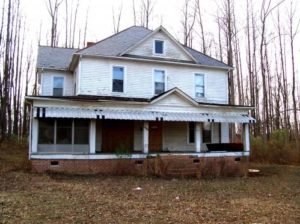
Photo from Preservation North Carolina.
The owner has restored this former farmhouse. Photographs of the house before restoration show a structure desperately in need of attention. The house was moved from its original site in 2001. The owner noted that the house had been abandoned, and wildlife and vagrants had caused much damage. Also, extensive water damage required the replacement of most plaster walls and ceilings throughout the house. The owner was able to preserve and restore many original elements, including interior moulding, wood flooring, and other woodwork. Updates made to the home have taken into consideration the property’s proposed change of usage to commercial, and changes were made to meet code requirements.
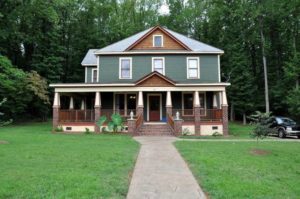
Exterior Description
At its current location, the Abernethy House is built upon a continuous brick foundation. Crawl space ventilation is provided by metal grates spaced unevenly around the newly-stuccoed exterior foundation wall. The house is wood-framed with original wood slat siding. Original double-hung one-over-one wood sash windows, many with the original glass, have been retained as well as the two exterior doors opening onto the front porch. The slate hip roof also has been retained. Two brick chimneys, no longer in use, are symmetrically located within the front elevation, although the north chimney sits farther back in plan than the southern chimney.
The primary massing of the house is comprised of the two-story section, and will be considered the principal portion of the structure for the purpose of this report. Along the back elevation of the Abernethy house are one-story sections with various roof heights and configurations. These sections are mostly original to the house, but will be treated as extensions.
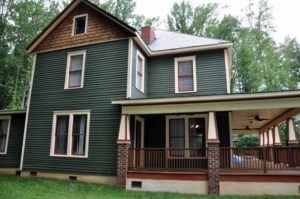
The front elevation of the Abernethy House demonstrates the mix of architectural styles found in the property. It is three bays wide. A new stamped concrete sidewalk leads up to the house. New brick steps featuring brick piers with split cast stone caps lead up to the front porch. The piers are topped with white-enameled electric post lights. Wood railings with square pickets and brick cheek walls flank the steps. The wrap-around front porch, a feature consistent with the Queen Anne Style, has a new wood plank flooring. Partial height tapered posts resting on brick piers with rough-face stone caps, common to the Craftsman Style that was finding popularity in Charlotte at the time of the house’s original construction, have been added to replace the damaged original 10-inch square wood columns. A simple wood railing with square pickets and moulded beveled top-rail has been added to meet code requirements. The front porch has a hipped/shed roof with asphalt architectural shingles. A center gable with cedar shake siding, aligned with the front door, highlights the entry to the house. Head beams supporting the porch roof feature flared wood trim along the bottom face as well as wood moulding in the center and crown moulding between the beam and roof overhang. The porch ceiling is original beadboard.
The front door is an original half-light solid wood door with a singular upper panel and two lower panels. Along with the center porch gable, the front door is located off-center in the front elevation between two paired windows . The upper story of the front facade has three single windows placed equally along the elevation, with the two outer windows aligning with the lower story fenestration. The hip roof features a centered gable with cedar shingle siding and a fixed wood-sash window. Centralized focal roof elements such as the porch and roof gables are common to the Colonial Revival Style. An asymmetrical wing, one bay wide and one bay deep, extends out from the north elevation of the Abernethy House. The south wing forms one end of the wrap-around porch. The secondary door onto the porch identical to the front door and a single window in the upper floor align in the front elevation.
The south elevation of the Abernethy house is reflective of the common domestic architecture in Mecklenburg County in the first decades of the twentieth century. The elevation is two bays wide. The two bay elevations are identical in that they have paired windows on the lower story and single windows on the upper story. The left bay consists of the cross-gable wing, a feature common to the Queen Anne Style, coming off the hip roof of the principal section of the house. The wing is one bay deep and provides the depth necessary for the wrap-around porch. The gable section of the wing features new cedar shake siding, applied over the original wood siding, and a fixed wood-sash window. A low brick chimney appears in this bay.
The back elevation of the Abernethy house features the upper story of the house’s core as well as one-story sections with various roof layouts. It is three bays wide. The upper story features the slate hip roof as well as the south cross-gable that continues the slope of the hip. Each bay features a single window. The middle window is not centered on the elevation. The one-story extension is five bays wide. The roof configuration is varied, with both hip and shed roofs, but all feature asphalt architectural shingles. The back elevation has new tempered-hardboard siding cut to match the original wood siding on the principal mass of the house.
The south elevation of this section is one bay wide and steps back approximately twelve inches from the principal section of the house. The elevation features a double-hung window. The low-sloped hip roof intersects the upper story of the back elevation at its peak. The south elevation of this one-story section has retained its original wood siding.
Starting from the right side of the lower back elevation, the first bay is a bathroom addition made at a later date. It has a new double-hung one-over-one wood sash window. This bay is clad with tempered-hardboard siding cut to match the original wood siding. The second bay has a two-by-four glass block opening. The third bay features the new back door. These two bays once were a screened porch, but were later enclosed, and are set back one bay within the elevation. They also are clad in new tempered-hardboard siding. The fourth bay has a new double-hung wood sash window. The hip roof of this bay is higher-sloped than the other roof sections. The last bay features a new double-hung one-over-one wood sash window. The head height of this window is lower than the window heads in the other bays, as is the hip roof that meets the lower edge of the adjacent bay’s roof. This bay once served as a portico entrance into the kitchen, but was later enclosed. A new wood handrail is attached to the siding of this bay. New brick steps lead up to a semi-circular stamped concrete patio. Low concrete seating walls with stone-capped brick piers give the space a sense of enclosure.
The north elevation of the one-story extension is two bays wide and is clad in new tempered-hardboard siding. Both bays have a wood-sash window, formerly original tilt windows but now a fixed window with new glazing.

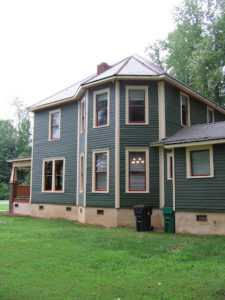
The north elevation of the Abernethy house is two bays wide. The left bay has paired windows on the lower story and a single window on the upper story. These windows are centered within the bay. A low brick chimney is set approximately centered between the two bays. The right bay features a three-sided two story projecting bay topped with a slate hip roof. Reminiscent of the Queen Anne Style, this element has single windows on both the lower and upper stories centered in each side of the bay.
Interior Description
Despite the poor condition of the house upon the owner’s acquisition of the property in 2009, the interior of the Abernethy House has retained many of its original architectural details. The original oak plank flooring, damaged by water from roof leakage, was salvaged on the first and second stories, as was the original beadboard ceiling on the second story. Original wood baseboards with moulded caps are found throughout the house, although some baseboards were not salvageable and were replaced with similar materials. Solid wood six-panel doors have been refinished, although most of the original hardware was beyond salvage.

Much of the woodwork points toward the Craftsman Style through the use of simplified ornamentation. Original windows with wood trim are prominent throughout the principal two-story section of the Abernethy House. They feature a simplified cornice with cap moulding, side casing with a wide reveal profile, and a bullnosed horn over the apron. The house also features original door trim, with a simplified cornice with cap moulding similar to that of the windows. Some trim, however, was not salvageable and was made to match the original.

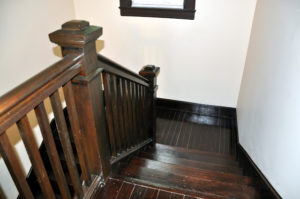
The dining room of the Abernethy House features many Craftsman Style details. Many original architectural elements have been retained despite the dilapidated condition of the house before rehabilitation. Bottom photo from Preservation North Carolina.
The front entrance leads into the parlor, which features an original large wood mantle. To the right is the study, which has a smaller original wood mantle. Pocket doors once divided the study and the parlor. However, the original doors had been removed when the owner took possession of the house, and the door slots are non-existent. The dining room is accessible through either the central hallway or a doorway from the study. This room features a built-in bookcase next to the original fireplace mantle. Original wood beadboard wainscoting lines the walls and is topped with a moulded chair rail. Most of the wainscoting in the hallway, however, was beyond salvage, and new beadboard has been installed. All fireplaces in the Abernethy House are no longer fully functioning, and electric fireplaces have been installed along with new marble hearths on the first story. Through the central hallway, rooms in the back of the house may be accessed, including an updated kitchen with adjacent pantry and laundry room, butler’s pantry, two bedrooms with adjacent full baths, and a half bath made handicap accessible.

The staircase leading up the second story is fully original. Bullnosed wood treads with underlying cove moulding top the risers. Moulded wood railings are supported by square balusters. Square newel posts, which receive the railings, feature wood trim just below the railings and moulded caps. The posts extend past the the ceiling of the first story. The staircase framing as well as the stringers are accented with wood panels and curved moulding.
The second story of the Abernethy House is practically unchanged from its original layout. Four bedrooms are situated around a central hallway that extends to the front of the house. Only one bedroom has been substantially changed to accommodate a full bathroom, which the second floor previously did not have. A new doorway similar to the existing original ones was installed. Many original architectural features are evident. The salvaged beadboard ceiling is reinforced with new wood beams with crown moulding. Original wood baseboards with cap moulding, similar to the baseboards in the first story though smaller in height, have been saved. Openings where heaters once stood at the chimneys have been sealed with beadboard, and the original hearths have been retained.

An original door opening (right) in comparison to a new door opening (left) in the second story.

